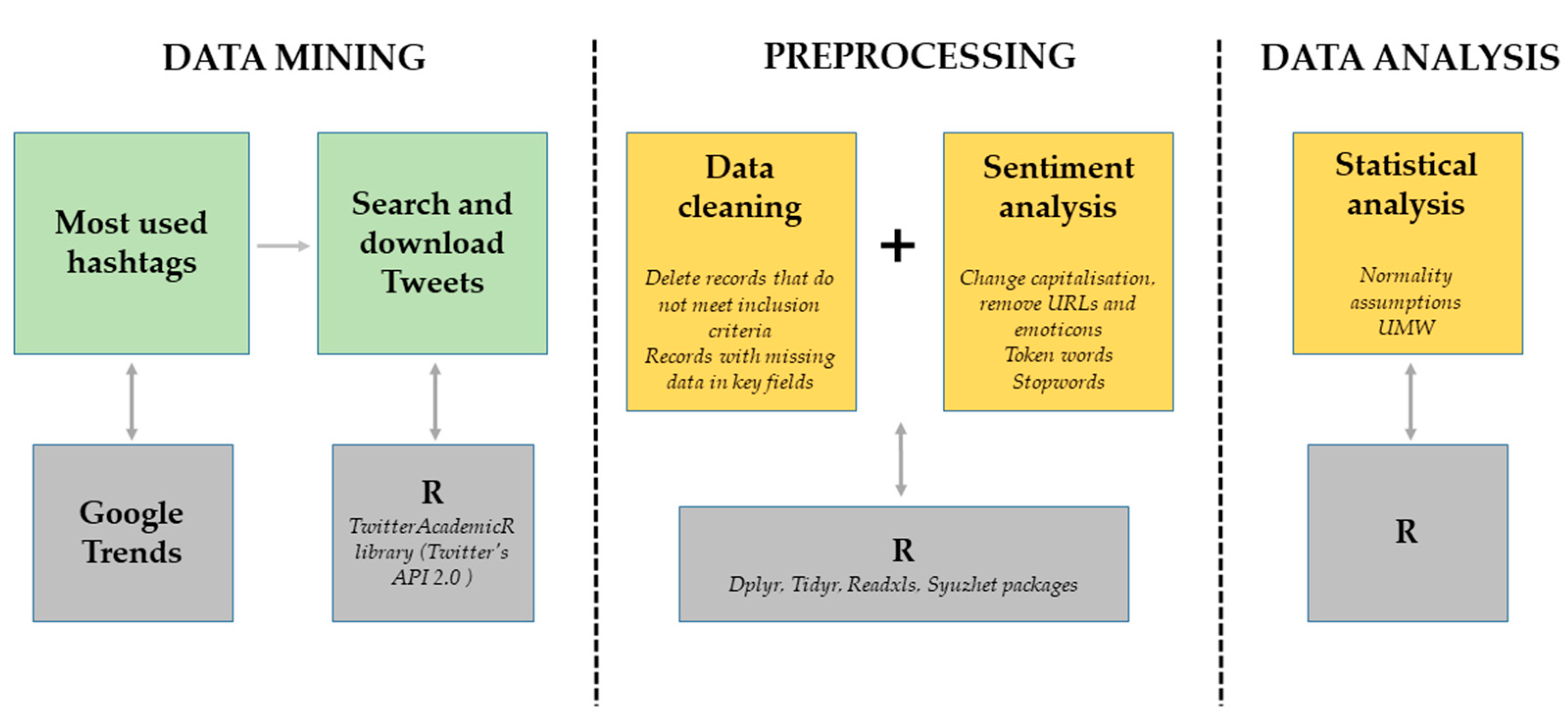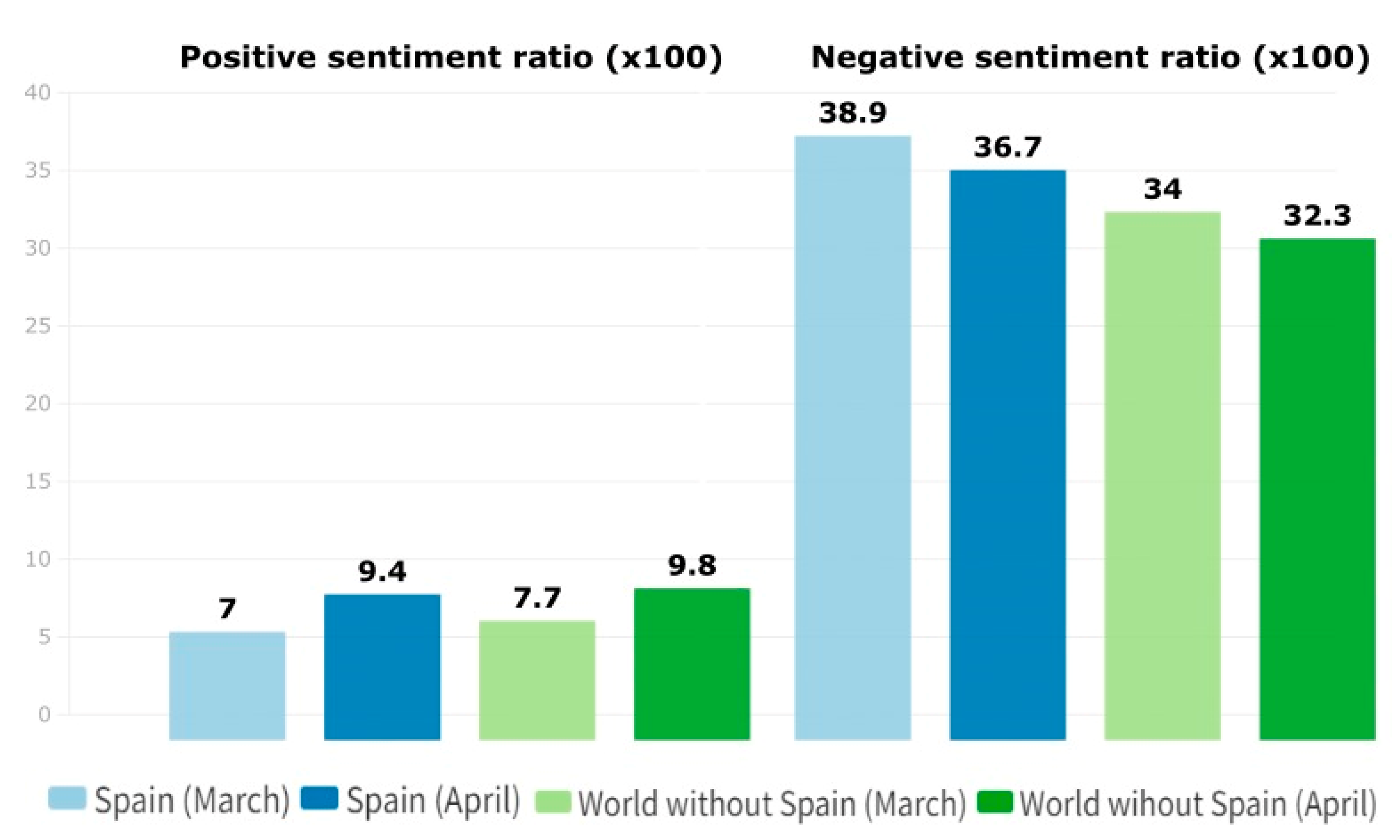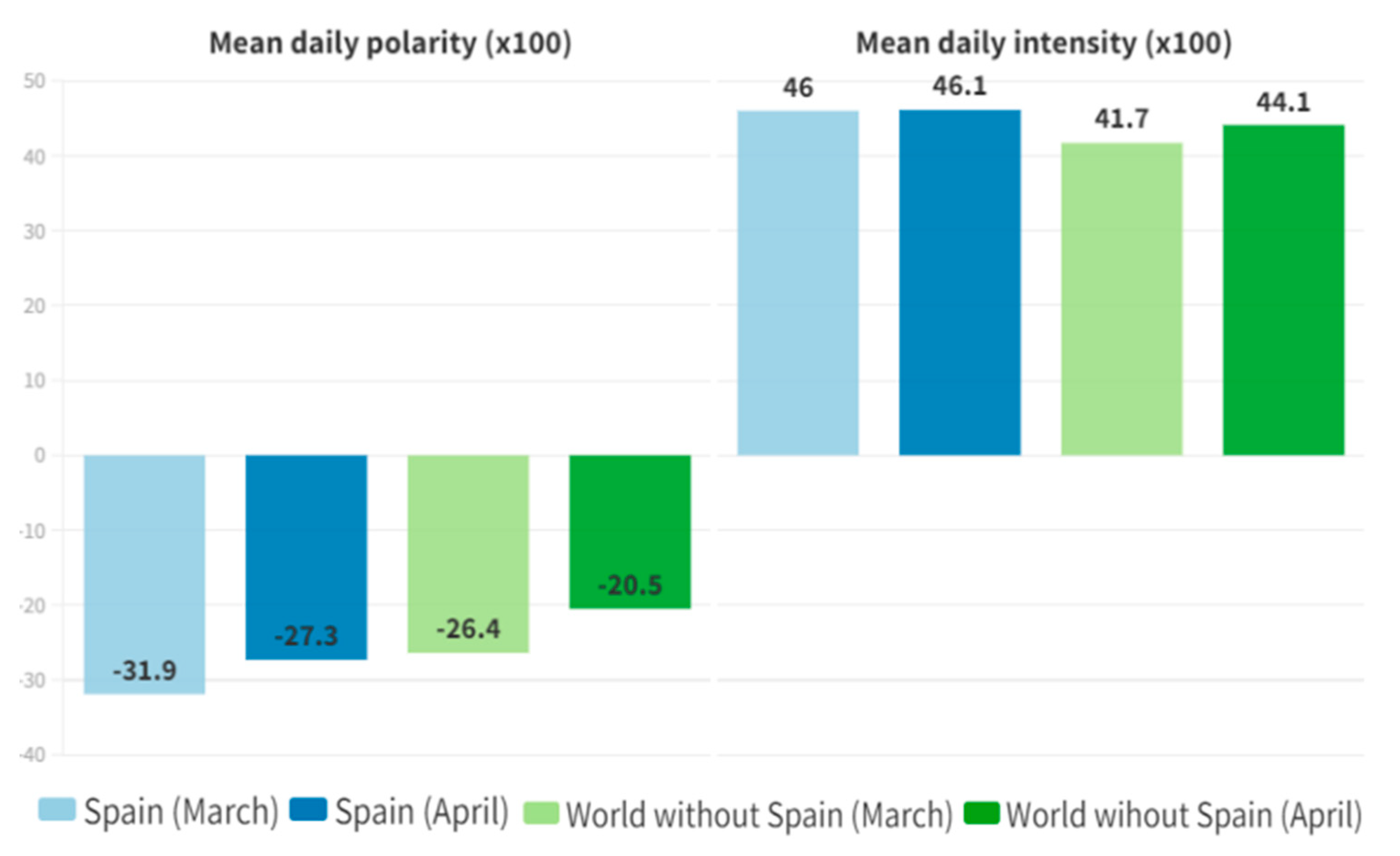Sentiment Analysis on Twitter: Role of Healthcare Professionals in the Global Conversation during the AstraZeneca Vaccine Suspension
Abstract
1. Introduction
2. Materials and Methods
2.1. Study Design and Ethics
2.2. Data Collection
2.3. Variables for Analysis
2.4. Data Analysis
3. Results
3.1. Descriptive Analysis
3.2. Sentiment, Polarity, and Intensity
3.3. Intragroup Analysis
3.4. Intergroup Analysis
4. Discussion
5. Conclusions
Author Contributions
Funding
Institutional Review Board Statement
Informed Consent Statement
Data Availability Statement
Conflicts of Interest
References
- Ahorsu, D.K.; Lin, C.Y.; Pakpour, A.H. The Association Between Health Status and Insomnia, Mental Health, and Preventive 462 Behaviors: The Mediating Role of Fear of COVID-19. Gerontol. Graitr. Med. 2020, 6, 9. [Google Scholar] [CrossRef]
- Balanza-Martinez, V.; Atienza-Carbonell, B.; Kapczinski, F.; De Boni, R.B. Lifestyle behaviours during the COVID-19-time to 483 connect. Acta Psychiatr. Scand. 2020, 141, 399–400. [Google Scholar] [CrossRef] [PubMed]
- Asante, L.A.; Mills, R.O. Exploring the Socio-Economic Impact of COVID-19 Pandemic in Marketplaces in Urban Ghana. Afr. Spectr. 2020, 55, 170–181. [Google Scholar] [CrossRef]
- Cascini, F.; Pantovic, A.; Al-Ajlouni, Y.; Failla, G.; Ricciardi, W. Attitudes, acceptance and hesitancy among the general populationworldwide to receive the COVID-19 vaccines and their contributing factors: A systematic review. EClinical Med. 2021, 40, 101113. [Google Scholar] [CrossRef] [PubMed]
- Ten Threats to Global Health in 2019. World Health Organization. 2019. Available online: https://www.who.int/news-room/spotlight/ten-threats-to-global-health-in-2019 (accessed on 15 December 2022).
- European Medicines Agency. Available online: https://www.ema.europa.eu/en/news/astrazenecas-covid-19-vaccine-ema-finds-possible-link-very-rare-cases-unusual-blood-clots-low-blood (accessed on 15 December 2022).
- Hsieh, Y.L.; Rak, S.; SteelFisher, G.K.; Bauhoff, S. Effect of the suspension of the J&J COVID-19 vaccines on vaccinne hesitancy in the United States. Vaccine 2021, 40, 424–427. [Google Scholar] [CrossRef] [PubMed]
- European Medicines Agency. Available online: https://www.ema.europa.eu/en/news/covid-19-vaccine-astrazeneca-prac-preliminary-view-suggests-no-specific-issue-batch-used-austria (accessed on 17 December 2022).
- Spanish Agency for Medicines and Medical Devices. Available online: https://www.aemps.gob.es/informa/notasinformativas/medicamentosusohumano-3/seguridad-1/2021-seguridad-1/el-ministerio-de-sanidad-suspende-a-partir-de-manana-y-durante-las-dos-proximas-semanas-la-vacunacion-con-la-vacuna-frente-a-la-covid-19-de-astrazeneca/ (accessed on 17 December 2022).
- European Medicines Agency. Available online: https://www.ema.europa.eu/en/news/covid-19-vaccine-janssen-ema-finds-possible-link-very-rare-cases-unusual-blood-clots-low-blood (accessed on 17 December 2022).
- Smadja, D.M.; Yue, Q.Y.; Chocron, R.; Sanchez, O.; Lillo-Le Louet, A. Vaccination against COVID-19: Insight from arterial and venous thrombosis occurrence using data from VigiBase. Eur. Respir. J. 2021, 58, 2100956. [Google Scholar] [CrossRef]
- Ruiz-Nuñez, C.; Segado-Fernández, S.; Jimenez-Gómez, B.; Jiménez Hidalgo, P.J.; Romero Magdalena, C.S.; Águila Pollo, M.D.C.; Santillán-García, A.; Herrera-Peco, I. Bot’s activity on COVID-19 Pro and Antivaccination networks analysis of Spanish-written messages on Twitter. Vaccines 2022, 1088, 1240. [Google Scholar] [CrossRef]
- Bora, K.; Das, D.; Barman, B.; Borah, P. Are internet videos useful sources of information during global public health emergencies? A case study of Youtube videos during the 2015-2016 Zika virus pandemic. Pathog. Glob. Health. 2018, 112, 320–328. [Google Scholar] [CrossRef]
- Fung, I.C.; Fu, K.W.; Chan, C.H.; Chan, B.S.; Cheung, C.N.; Abraham, T.; Tse, Z. Social Media’s Initial Reaction to Information and Misinformation on Ebola, August 2014: Facts and Rumors. Public Health Rep. 2016, 131, 461–473. [Google Scholar] [CrossRef]
- Allcott, H.; Gentzkow, M. Social Media and Fake News in the 2016 Election. J. Econ. Perspectiv. 2017, 31, 211–236. [Google Scholar] [CrossRef]
- Li, J.; Xu, Q.; Cuomo, R.; Purushothaman, V.; Mackey, T. Data mining and content analysis of the Chinese social media platform Weibo during the early COVID-19 outbreak: Retrospective observational infoveillance study. JMIR Public Health Surveill. 2020, 6, e18700. [Google Scholar] [CrossRef] [PubMed]
- Chew, C.; Eysenbach, G. Pandemics in the age of Twitter: Content analysis of Tweets during the 2009 H1N1 outbreak. PLoS ONE 2010, 5, e14118. [Google Scholar] [CrossRef] [PubMed]
- Karami, A.; Lundy, M.; Webb, F.; Turner-McGrievy, G.; McKeever, B.W.; McKeever, R. Identifying and Analyzing Health-Related Themes in Disinformation Shared by Conservative and Liberal Russian Trolls on Twitter. Int. J. Environ. Res. Public Health. 2021, 18, 2159. [Google Scholar] [CrossRef] [PubMed]
- Corley, C.D.; Cook, D.J.; Mikler, A.R.; Singh, K.P. Text and structural data mining of influenza mentions in web and social media. Int. J. Environ. Res. Public Health 2010, 7, 596–615. [Google Scholar] [CrossRef] [PubMed]
- Karami, A.; Zhu, M.; Goldschmidt, B.; Boyajieff, H.R.; Najafabadi, M.M. COVID-19 vaccine and social media in the U.S.: Exploring emotions and discussions on Twitter. Vaccines 2021, 9, 1059. [Google Scholar] [CrossRef]
- Cines, D.B.; Bussel, J.B. SARS-CoV-2 Vaccine-Induced Immune Thrombotic Thrombocytopenia. N. Engl. J. Med. 2021, 384, 2254–2256. [Google Scholar] [CrossRef]
- Wilson, S.L.; Wiysonge, C. Social media and vaccine hesitancy. BMJ Glob. Health 2020, 5, e004206. [Google Scholar] [CrossRef]
- Hernandez, A.F.; Calina, D.; Poulas, K.; Docea, A.O.; Tsatsakis, A.M. Safety of COVID-19 vaccines administered in the EU: Should we be concerned? Toxicol. Rep. 2021, 8, 871–879. [Google Scholar] [CrossRef]
- Konstantinides, S. Thrombotic complications of vaccination against SARS-CoV-2: What pharmacovigilance reports tell us—And what they don’t. Eur. Respir. J. 2021, 58, 2101111. [Google Scholar] [CrossRef]
- Suarez-Lledo, V.; Alvarez-Galvez, J. Assessing the Role of Social Bots During the COVID-19 Pandemic: Infodemic, Disagreement, and Criticism. J. Med. Internet Res. 2022, 24, e36085. [Google Scholar] [CrossRef]
- Eslinger, P.J.; Anders, S.; Ballarini, T.; Boutros, S.; Krach, S.; Mayer, A.V.; Moll, J.; Newton, T.L.; Schroeter, M.L.; de Oliveira-Souza, R.; et al. The neuroscience of social feelings: Mechanisms of adaptive social functioning. Neurosci. Biobehav. Rev. 2021, 18, 592–620. [Google Scholar] [CrossRef] [PubMed]
- Sailunaz, K.; Reda, A. Emotion and sentiment analysis from Twitter text. J. Comput. Sci. 2019, 36, 101003. [Google Scholar] [CrossRef]
- Bryan, V.M.; Mayer, J.D. Are People-Centered Intelligences Psychometrically Distinct from Thing-Centered Intelligences? A Meta-Analysis. J. Intell. 2021, 9, 48. [Google Scholar] [CrossRef] [PubMed]
- Benrouba, F.; Boudour, R. Emotional sentiment analysis of social media content for mental health safety. Soc. Netw. Anal. Min. 2023, 13, 17. [Google Scholar] [CrossRef]
- Wang, Q.; Su, T.; Lau, R.Y.K.; Xie, H. DeepEmotionNet: Emotion mining for corporate performance analysis and prediction. Inf. Process. Manag. 2023, 60, 103151. [Google Scholar] [CrossRef]
- Choi, E.-J.; Choi, Y.-J. The early emotional responses and central issues of people in the epicenter of the COVID-19 pandemic: An analysis from twitter text mining. Int. J. Ment. Health Promot. 2023, 25, 21–29. [Google Scholar] [CrossRef]
- Păvăloaia, V.-D.; Teodor, E.-M.; Fotache, D.; Danileţ, M. Opinion mining on social media data: Sentiment analysis of user preferences. Sustainability 2019, 11, 64459. [Google Scholar] [CrossRef]
- Lyu, J.C.; Le Han, E.; Luli, g.K. COVID-19 vaccine-related discusson on Twtter: Topic modeling and sentiment analysis. J. Med. Internet Res. 2021, 23, e24435. [Google Scholar] [CrossRef]
- Jun, J.; Zain, A.; Chen, Y.; Kim, S.H. Adverse mentions, negative sentiment, and emotions in COVID-9 vaccine tweets and their association with vaccination uptake: Global comparison of 192 countries. Vaccines 2022, 10, 735. [Google Scholar] [CrossRef]
- Infodemia. Available online: https://www.who.int/health-topics/infodemic#tab=tab_1 (accessed on 22 December 2022).
- Tangcharoensathien, V.; Calleja, N.; Nguyen, T.; Purnat, T.; D’Agostino, M.; Garcia Saiso, S.; Landry, M.; Rashidian, A.; Hamilton, C.; Abdallah, A.; et al. Framework for Managing the COVID-19 Infodemic: Methods and Results of an Online, Crowdsourced WHO Technical Consultation. J. Med. Internet Res. 2020, 22, e19659. [Google Scholar] [CrossRef]
- Shi, W.; Yang, J.; Zhang, J.; Wen, S.; Su, J. Social bots’ sentiment engagement in health emergencies: A topic-based analysis of theCOVID-19 pandemic discussions on Twitter. Int. J. Environ. Res. Public Health 2020, 17, 28701. [Google Scholar] [CrossRef] [PubMed]
- Barrie, C.; Ho, J. AcademictwitteR: An R package to access the Twitter Academic Research Product Track v2 API endpoint. J Open Source Softw. 2021, 6, 3272. [Google Scholar] [CrossRef]
- Soubra, R.; Hasn, I.; Ftouni, L.; Saab, A.; Shaarani, I. Future healthcare providers and professionalism on social media: A cross-sectional study. BMC Med. Ethics 2022, 23, 4. [Google Scholar] [CrossRef] [PubMed]
- Wang, Z.; Wang, S.; Zhang, Y.; Jiang, X. Social media usage and online professionalism among nurses: A cross-sectional survey. Int. J. Nurs. Stud. 2019, 98, 19–26. [Google Scholar] [CrossRef] [PubMed]
- Herrera-Peco, I.; Jiménez-Gómez, B.; Romero-Magdalena, C.S.; Deudero, J.J.; García-Puente, M.; Benítez de Gracias, E.; Ruiz-Núñez, C. Antivaccine movement and COVID-19 negationism: A content analysis of Spanish-written messages on Twitter. Vaccines 2021, 9, 656. [Google Scholar] [CrossRef]
- Gisondi, M.A.; Barber, R.; Faust, J.S.; Raja, A.; Strehlow, M.C.; Westafer, L.M.; Gottlieb, M. A Deadly Infodemic: Social Media and the Power of COVID-19 Misinformation. J. Med. Internet Res. 2022, 24, e35552. [Google Scholar] [CrossRef]
- Ventola, C.L. Social Media and Health Care Professionals: Benefits, Risks, and Best Practices. Pharm. Ther. 2014, 39, 491. [Google Scholar]
- Schwenk, E.; Jaremko, K.M.; Park, B.H.; Stiegler, M.A.; Gamble, J.G.; Chu, L.F.; Utengen, A.; Mariano, E.R.I. Tweet, Therefore I Learn. Anesth. Analg. 2020, 130, 333–340. [Google Scholar] [CrossRef]
- Shiferaw, K.B.; Mehari, E.A. Internet use and eHealth literacy among health-care professionals in a resource-limited setting: A cross-sectional survey. Adv. Med. Educ. Pract. 2019, 10, 563–570. [Google Scholar] [CrossRef]
- Gartrell, K.; Han, K.; Trinkoff, A.; Cho, H. Three-factor structure of the eHealth Literacy Scale and its relationship with nurses’ health-promoting behaviours and performance quality. J. Adv. Nurs. 2020, 76, 2522–2530. [Google Scholar] [CrossRef]
- Segado-Fernández, S.; Lozano-Estevan, M.D.C.; Jiménez-Gómez, B.; Ruiz-Núñez, C.; Jiménez Hidalgo, P.J.; Fernández-Quijano, I.; González-Rodríguez, L.; Santillán-García, A.; Herrera-Peco, I. Health literacy and critical lecture as key elements to detect and reply to nutrition misinformation on social media: Analysis among Spanish healthcare professionals. Int. J. Environ. Res. Public Health 2023, 20, 10023. [Google Scholar] [CrossRef] [PubMed]
- Saleh, S.N.; Lehmann, C.U.; McDonald, S.A.; Basit, M.A.; Medford, R.J. Understanding public perception of coronavirus disease 2019 8COVid-19) social distancing on Twitter. Infect. Control Hosp. Epidemiol. 2021, 42, 31–138. [Google Scholar] [CrossRef] [PubMed]
- Ahmed, W.; Vidal-Alaball, J.; Vilaseca, J.M. A Social Network Analysis of Twitter Data Related to Blood Clots and Vaccines. Int. J. Environ. Res. Public Health 2022, 19, 84584. [Google Scholar] [CrossRef]
- Lwin, M.O.; Lu, J.; Sheldenkar, A.; Schulz, P.J.; Shin, W.; Gupta, R.; Yang, Y. Global sentiments surrounding the COVID-19 pandemic on Twitter: Analysis of Twitter trends. JMIR Public Health Surveill. 2020, 6, e19447. [Google Scholar] [CrossRef] [PubMed]
- Geronikolou, S.; Drosatos, G.; Chrousos, G. Emotional analysis of Twitter posts during the first phase of the COVID-19 pandemic in Greece: Infoveillance study. JMIR Form. Res. 2021, 5, e27741. [Google Scholar] [CrossRef] [PubMed]
- Mutlu, E.C.; Oghaz, T.; Jasser, J.; Tutunculer, E.; Rajabi, A.; Tayebi, A.; Ozmen, O.; Garibay, I. A stance data set on polarized conversations on Twitter about the efficacy of Hydroxychloroquine as a treatment for COVID-19. Data Brief. 2020, 3, 106401. [Google Scholar] [CrossRef] [PubMed]
- Rubin, R. When physicians spread unscientific information about COVID-19. JAMA 2022, 327, 904–906. [Google Scholar] [CrossRef]
- Fotsch, R. Who to believe? Consequences for physicians and nurses who spread misinformation. J. Nurs. Regul. 2022, 13, 70–72. [Google Scholar] [CrossRef]



| Worldwide 7 March 2021 to 23 March 2021 | ||||||
| n | Mean | Median | 95% CI | SD | ||
| Lower | Top | |||||
| Tweets | 4,409,923 | 259,407.24 | 202,682.00 | 163,976.32 | 354,838.15 | 185,608.17 |
| Interactions | 4,4710,821 | 2,630,048.29 | 4,613,960.96 | 646,135.63 | 4,613,960.96 | 4,613,960.96 |
| Worldwide 7 April 2021 to 23 April 2021 | ||||||
| n | Mean | Median | 95% CI | SD | ||
| Lower | Top | |||||
| Tweets | 28,734 | 1690.24 | 1367.00 | 1230.23 | 2150.24 | 894.69 |
| Interactions | 315,361 | 18,550.65 | 8663.00 | 8990.28 | 28,111.01 | 18,594.41 |
| Spain | Rest of the World | |||||||||
| 7 March 2021 to 23 March 2021 | ||||||||||
| Mean | Median | 95% CI | SD | Mean | Median | 95% CI | SD | |||
| Lower | Top | Lower | Top | |||||||
| Tweets | 21,515.71 | 15,821.00 | 13,141.97 | 29,889.44 | 16,286.49 | 237,891.53 | 186,861.00 | 147,696.68 | 328,086.38 | 175,424.30 |
| Interactions | 75,774.76 | 68,197.00 | 44,096.48 | 107,453.05 | 61,612.62 | 2,554,273.53 | 1,487,300.00 | 579,803.91 | 4,528,743.15 | 3,840,240.79 |
| 7 April 2021 to 23 April 2021 | ||||||||||
| Mean | Median | 95% CI | SD | Mean | Median | 95% CI | SD | |||
| Lower | Top | Lower | Top | |||||||
| Tweets | 571.53 | 381.00 | 330.04 | 813.01 | 469.68 | 1118.71 | 1081.00 | 856.41 | 1381.01 | 510.16 |
| Interactions | 6650.47 | 1620.00 | 1636.26 | 11,664.68 | 9752.38 | 11,900.18 | 7558.00 | 5309.36 | 18,491.00 | 12,818.80 |
| Spain | Rest of the World | |||||||||||
| 7 March 2021 to 23 March 2021 | ||||||||||||
| n | Mean | Median | 95% CI | SD | n | Mean | Median | 95% CI | SD | |||
| Lower | Top | Lower | Top | |||||||||
| Positive messages | 21,906 | 21,515.71 | 15,821.00 | 13,141.97 | 29,889.44 | 16,286.49 | 288,502 | 237,891.53 | 186,861.00 | 147,696.68 | 328,086.38 | 175,424.30 |
| Negative messages | 149,655 | 4,613,960.96 | 107,453.05 | 44,096.48 | 107,453.05 | 61,612.62 | 1,433,149 | 2,554,273.53 | 1,487,300.00 | 579,803.91 | 4,528,743.15 | 3,840,240.79 |
| Positive DSR | 0.070 | 0.054 | 0.045 | 0.096 | 0.050 | 0.077 | 0.072 | 0.063 | 0.090 | 0.027 | ||
| Negative DSR | 0.389 | 0.396 | 0.354 | 0.424 | 0.068 | 0.340 | 0.342 | 0.306 | 0.375 | 0.068 | ||
| Daily polarity | −0.319 | −0.342 | −0.372 | −0.266 | 0.104 | −0.264 | −0.272 | −0.307 | −0.220 | 0.085 | ||
| Daily intensity | 0.460 | 0.440 | 0.429 | 0.490 | 0.060 | 0.417 | 0.404 | 0.387 | 0.446 | 0.582 | ||
| 7 April 2021 to 23 April 2021 | ||||||||||||
| n | Mean | Median | 95% CI | SD | n | Mean | Median | 95% CI | SD | |||
| Lower | Top | Lower | Top | |||||||||
| Positive messages | 1049 | 571.53 | 381.00 | 330.04 | 813.01 | 469.68 | 2141 | 1118.71 | 1081.00 | 856.41 | 1381.01 | 510.16 |
| Negative messages | 3555 | 6650.47 | 1620.00 | 1636.26 | 11,664.68 | 9752.38 | 6423 | 11,900.18 | 7558.00 | 5309.36 | 18,491.00 | 12,818.80 |
| Positive DSR | 0.094 | 0.082 | 0.060 | 0.128 | 0.066 | 0.118 | 0.102 | 0.081 | 0.154 | 0.071 | ||
| Negative DSR | 0.367 | 0.359 | 0.321 | 0.413 | 0.090 | 0.323 | 0.321 | 0.285 | 0.361 | 0.075 | ||
| Daily polarity | −0.273 | −0.287 | −0.336 | −0.211 | 0.121 | −0.205 | −0.216 | −0.272 | −0.139 | 0.129 | ||
| Daily intensity | 0.461 | 0.434 | 0.409 | 0.513 | 0.101 | 0.441 | 0.448 | 0.406 | 0.476 | 0.068 | ||
Disclaimer/Publisher’s Note: The statements, opinions and data contained in all publications are solely those of the individual author(s) and contributor(s) and not of MDPI and/or the editor(s). MDPI and/or the editor(s) disclaim responsibility for any injury to people or property resulting from any ideas, methods, instructions or products referred to in the content. |
© 2023 by the authors. Licensee MDPI, Basel, Switzerland. This article is an open access article distributed under the terms and conditions of the Creative Commons Attribution (CC BY) license (https://creativecommons.org/licenses/by/4.0/).
Share and Cite
Ruiz-Núñez, C.; Herrera-Peco, I.; Campos-Soler, S.M.; Carmona-Pestaña, Á.; Benítez de Gracia, E.; Peña Deudero, J.J.; García-Notario, A.I. Sentiment Analysis on Twitter: Role of Healthcare Professionals in the Global Conversation during the AstraZeneca Vaccine Suspension. Int. J. Environ. Res. Public Health 2023, 20, 2225. https://doi.org/10.3390/ijerph20032225
Ruiz-Núñez C, Herrera-Peco I, Campos-Soler SM, Carmona-Pestaña Á, Benítez de Gracia E, Peña Deudero JJ, García-Notario AI. Sentiment Analysis on Twitter: Role of Healthcare Professionals in the Global Conversation during the AstraZeneca Vaccine Suspension. International Journal of Environmental Research and Public Health. 2023; 20(3):2225. https://doi.org/10.3390/ijerph20032225
Chicago/Turabian StyleRuiz-Núñez, Carlos, Ivan Herrera-Peco, Silvia María Campos-Soler, Álvaro Carmona-Pestaña, Elvira Benítez de Gracia, Juan José Peña Deudero, and Andrés Ignacio García-Notario. 2023. "Sentiment Analysis on Twitter: Role of Healthcare Professionals in the Global Conversation during the AstraZeneca Vaccine Suspension" International Journal of Environmental Research and Public Health 20, no. 3: 2225. https://doi.org/10.3390/ijerph20032225
APA StyleRuiz-Núñez, C., Herrera-Peco, I., Campos-Soler, S. M., Carmona-Pestaña, Á., Benítez de Gracia, E., Peña Deudero, J. J., & García-Notario, A. I. (2023). Sentiment Analysis on Twitter: Role of Healthcare Professionals in the Global Conversation during the AstraZeneca Vaccine Suspension. International Journal of Environmental Research and Public Health, 20(3), 2225. https://doi.org/10.3390/ijerph20032225







